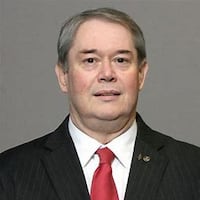More than 100 people gathered indoors at Miami Hamilton’s Parrish Auditorium due to inclement weather to see officials turn a shovel full of dirt gathered on the stage in the symbolic gesture. Work on the project began a few months months ago with relocating utility lines and construction preparation.
Jim Blount, chairman of the Butler County Transportation Improvement District and local historian, said there have been 10 previous attempts since the 1890s to address and resolve this key infrastructure issue that has previously stalled due to economic depressions, recessions, the 1913 flood, World Wars and missed opportunities for federal funds among others.
Blount, who has long championed the need for an overpass over the four sets of railroad tracks, said construction is underway because of cooperative effort among local, regional and state partners.
“I never thought I would see it happen,” he said. “I’m certainly glad to see it happen. It’s taken a lot of people and it’s taken a lot of effort.”
Fifty-six trains come through the railroad tracks that bisect the city, with the crossing blocked more than 15 percent of the time, according to the city.
Vice Mayor Carla Fiehrer said the project will change the landscape and possibilities for the city’s 63,000 residents.
“The benefit for the city of Hamilton is immeasurable,” she said. “The possibilities are endless of what we can do out here. This is huge.”
Once completed in 2018, a new road extension and overpass will create a direct east/west route from Ohio 4 to University Boulevard.
It will provide a direct route to Miami University Hamilton and the Vora Technology Park, where 1,500 new jobs at the new BarclayCard processing facility will be located, and also open up between 50 to 60 acres of greenfield at the city-owned University Commerce Park for future development.
Officials also hope the new overpass eliminates safety issues such as car/train accidents where two lanes of Central Avenue cross four rail tracks owned by CSX and Norfolk Southern, as well as delaying first responders in emergencies due to traffic back-ups when trains are crossing.
About the Author
